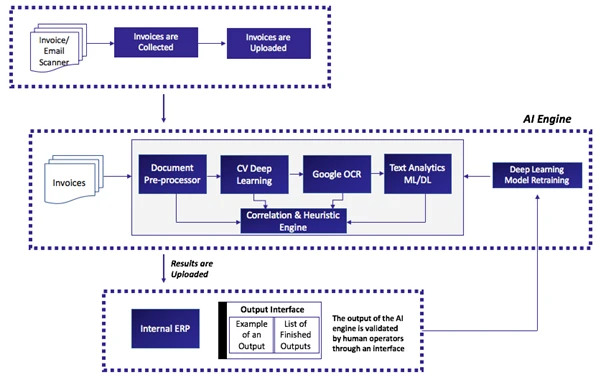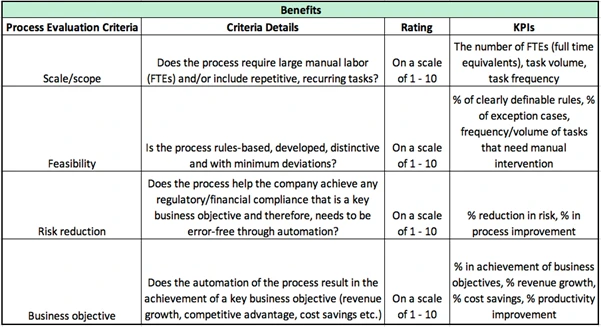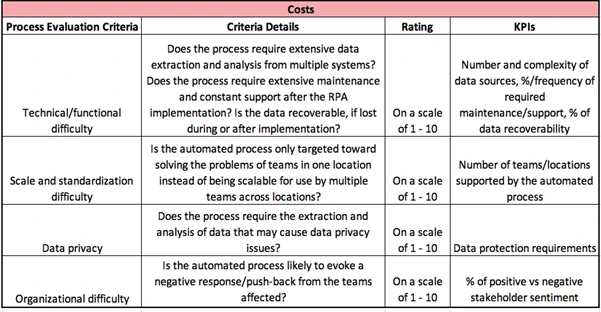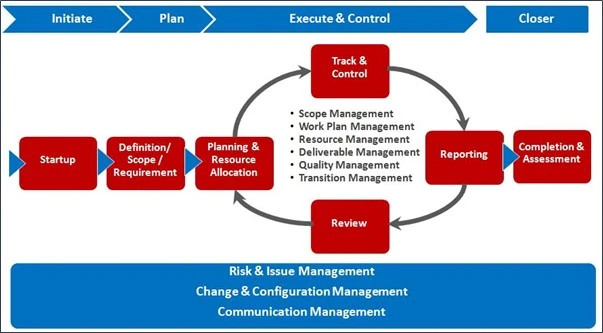Robotic Process Automation (RPA) requires no introduction. You are likely already aware of RPA and why it’s considered one of the most desired ‘emerging’ technologies. The benefits and business impact of automation (increased efficiency, minimalizing errors, cost savings etc.) make the investment worth it.When it comes to implementing any emerging technology within your healthcare business, a clear and detailed action plan makes any deployment painless. For example; invoice processing is one of the most commonly automated processes. In order to create a well-oiled AI engine (that has machine learning and retraining capabilities) to process invoices quickly and accurately, it is crucial to have a comprehensive research and project plan in place. Below is an example of what the final process flow for such an RPA project would look like.

Once you know you want it, you want to know how to get it. So we’ve put together a 9-step roadmap for RPA deployment and implementation.
- Identify processes that are potential candidates for automation
- Prioritize processes
- Get stakeholder alignment
- Dig deep into the process
- Select your technology collaborators
- Develop your solution
- Test, test, test! (and retrain your solution)
- Run a pilot
- Go live and plan for the future
Identify processes that are potential candidates for automation
Just like with any other big ask, you want to maximize the return on your RPA investment. To achieve this, identifying processes that are in definite need of automation is essential. Such processes tend to be:
-
Cost and/or revenue impactors:
This one is a given, but it’s just as important. Consider processes that are most expensive and affect external stakeholders (customers, suppliers etc.). For example; processing invoices from suppliers accurately and on time is a must, but manual invoice processing may leave something to be desired in terms of speed and efficiency. This is why invoice processing acts as a prime candidate for RPA.
-
Error-prone:
Since we’re on the topic of efficiency, processes that are open to human errors can lead to customer dissatisfaction and regulatory problems (depending on the probability and severity of errors). The more manual mistakes in a process, the more returns you can get by automating that process.
-
Defect-tolerant:
This one seems contradictory, but it’s actually not. We’re hoping to eliminate manual errors through automation, but if the process itself cannot bear any inaccuracies; you may not want to automate it just yet (or at least have a strong quality control protocol in place). This is because RPA bots rely on defined rules and user interfaces to perform tasks. If these rules/UI change, the bots’ output can have errors if they’re not configured to shift according to the tweaks in the process. For example; invoice processing is commonly automated. But invoices containing payments above a certain value need to be approved by humans because the bots are not trained to deal with payments above that value. Similarly, many companies still use manual teams to validate the bots’ output to catch any errors.
-
Voluminous and speed-sensitive:
When you think RPA, you think easier, quicker processes. Any processes that require a large volume of human effort and delay the product/service delivery to end clients can serve as good prospects for automation.
Prioritize processes that can be easily automated
Now, you want to shortlist the processes based on the ease and feasibility of implementation. Such processes are inclined to be:
-
Rule-based:
The crux of RPA is the bots being trained to follow programmable instructions and perform specific tasks. It is a given, then, that the process you select for automation has a set of rules that can be defined, mapped and programmed. It isn’t about only selecting processes with simplistic rules, but selecting processes with rules that can be clearly and comprehensively defined.
-
With minimum deviations:
Al bots, once trained with complex rules, can get deeper into the process and uncover rules that may be considered ‘a given’ by their human managers. Although this is a benefit of RPA; if a process has too many exception cases and unrecorded rules, it falls to the RPA implementation team to uncover and record these rules through interviews with process managers. This presents an added complexity in implementing RPA which can be avoided by simply picking a process that has fewer irregularities.
-
Developed:
Consider where the process is in its lifecycle. If it has recently been introduced and is still in the growth stage, it may not be a good fit for automation since it is regularly evolving and needs constant tweaks. To this end, legacy systems/ processes are a perfect fit for RPA because replacing them with an automated system not only allows you to break new ground with RPA in your company, but reinvents a legacy system you were meaning to replace anyway.
-
Distinctive:
This criteria looks purely at cost and effort estimates. Assess whether you are looking at a process specific to your healthcare business or if it’s an industry-wide, recognized process. If it’s a process many companies of similar sizes carry out (in similar ways), chances are there are already well-tested, well-developed RPA solutions in the market that you can use. This way, you don’t have to invest additional time, labor and money for a cost-effective, customized solution that you could easily research and buy.
While you’re contemplating and narrowing down your list of ideal processes, a cost-benefit analysis matrix can help speed things along:


Get stakeholder alignment
This directly follows the last criteria in the cost matrix above. You cannot possibly move forward without getting the internal stakeholders of your RPA implementation (senior management, process team and other business units) on the same page.
-
Senior management:
If you’re a small or medium sized healthcare business, the senior management is likely already actively involved in RPA discussions. In larger organizations though, it is sometimes needed to actively seek management buy-in by building a compelling business case. As with any other business case; creating a detailed, logical analysis based on costs, benefits and return on investment is the secret sauce.
-
Process team:
This is the team that currently operates and manages the process you are seeking to automate. If the process is managed in-house and something that the team took years to cultivate and nurture, you may encounter some resistance. Redundancy and not being valued for their work are people’s biggest concerns when it comes to automation. So it is vital to bring this team onboard by demonstrating the need for automation and lending proactive support for the post-automation ‘new normal’ (upskilling, finding jobs for them in the same team or other teams that are in need of their specific skills etc.).
-
Other business units:
Having the IT/technology experts at your company in the loop from the very beginning is a must. Having their inputs sooner rather than later can positively influence RPA research and business case preparation. They may shed light on whether any RPA was implemented by the company in the past, if any vendors were used and the experience. Not to forget, your RPA project should fit into the company’s future technical vision and technical experts are the go-to for this.
Dig deep into the process
After you get stakeholder alignment and before you start the development, you might want to thoroughly understand the process you are seeking to automate. This is where we understand and define the process rules we identified in step 2. Again (like in step 2), uncovering and recording these rules through interviews with process managers may not provide a completely accurate picture as some rules may be considered ‘a given’ by these managers who have used the process for years. In such cases, process mining can bring up rules that may not be apparent to human teams. For this purpose, process mining software uses transaction logs to find actual detailed process flows that clearly showcase each rule that the process includes.
Not to mention, this exercise of understanding the process may bring forth process improvement suggestions that you can implement before RPA. A common example is simplifying the process rules to ensure that RPA bots can easily be programmed and trained to follow them.
Select your technology collaborators
Although using a single RPA partner for an RPA deployment may seem quick and easy, you may want to consider a four-party strategy for a successful deployment in the long run and effective ROI:
-
Process mining software:
As discussed above, process mining can help you understand the process in its entirety (through detailed process flows and rules), weigh the feasibility for automation and monitor the effect of automation on the process in the years to come.
-
RPA technology provider:
It goes without saying that you need to do your due diligence when choosing a technology vendor; maybe also research factors that you should pay attention to when weighing your options.
-
AI/ML provider:
As identified in the cost matrix above, data needed for RPA implementation may need to be extracted and analyzed from multiple data sources. RPA is ideal for automating tasks once the data is in place, but to get data ready for automation, it may be worth considering AI/ML/data extraction providers. This is because RPA solution providers specialize in automation and their solutions for steps that precede automation may not fit your custom needs.
-
RPA implementation partner:
Of course, if you have come so far with an internal team, that team may choose to implement the project itself. But if you want to focus on your core operations and rely on industry expertise, you could look at a consulting company or BPO provider.
Develop your solution
Often, you may seek to automate some parts of a process rather than the entire process. Irrelevant of the scale of the project, creating a detailed process map is highly recommended. This is where the process team and subject matter experts at your company come in. Once the plan is in place, RPA bots can be programmed. Also, keeping tabs on your RPA platform’s marketplace may be useful, to discover readily available code and avoid coding from scratch.
Test, test, test!
The importance of testing your RPA solution cannot be overstated. Seemingly generic differences in scenarios (for example; using the solution on desktop vs mobile, on different operating systems etc.) can manifest unforeseen anomalies. Testing the solution (and then testing it again) is the only way to work out the kinks and get it ready for the pilot. You can also take this opportunity to retrain your solution so it is able to deliver quality outputs on a continuous basis.
Run a pilot
As the name suggests, you’ll be testing the actual output of the RPA bots you have developed. Just because it’s a pilot, doesn’t mean you should skip any steps you would follow while implementing an actual full-fledged project:
-
Set goals and objectives:
While a goal is an overarching aim of what you want to achieve from the pilot, objectives are the milestones that will help you get there. Make sure that your goals and objectives are SMART (specific, measurable, achievable, realistic, time-based).
-
Execute:
Get the RPA bots to perform pre-defined tasks in the process and get the process team to regularly review the output to assess its quality and efficiency.
-
Monitor and course correct if needed:
Evaluate the results of the entire pilot while factoring in outlier cases and exceptions.
Go live and plan for the future
Once the pilot achieves the pre-set targets, you are ready to plan and execute the full-fledged roll-out. Start with a project plan, this is where the project/implementation experts at your organization come in. Below is our tried-and-tested project management framework that we’ve used for 20+ years!

The following tools/concepts are amazing to develop a comprehensive, unambiguous project plan:
- Responsibility matrix (RACI)
- Communication matrix
- Project tracking and monitoring matrix
- Risk management and change management contingencies
- Quality assurance process
Once the plan is in place, all that’s left is to keep all stakeholders informed and go live! Make sure to follow the Agile and Scrum frameworks with 2 week sprints; this way you’ll receive constant iterative feedback from the target user which can be immediately applied to enrich product development.
Track, measure and analyze results (while and after RPA is deployed) against business objectives (cost savings, productivity improvement, revenue growth etc.). As identified in your project plan, it may also help to establish separate frameworks for routine maintenance of the solution, user support and training for the process team going forward.
If you’d rather focus on your core activities and leave the technical stuff to us, we’d love the chance to work with you as your decision support system and build an RPA solution completely suited to your exact requirements. Our experience serving healthcare clients over the years and our partnerships with RPA experts empower us to best serve you!

